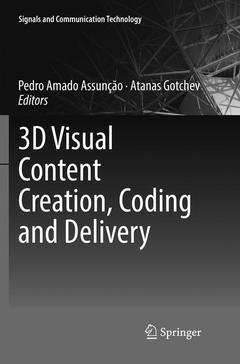Description
3D Visual Content Creation, Coding and Delivery, 1st ed. 2019
Signals and Communication Technology Series
Language: English
Subjects for 3D Visual Content Creation, Coding and Delivery:
Publication date: 02-2019
Support: Print on demand
Publication date: 08-2018
Support: Print on demand
Description
/li>Contents
/li>Biography
/li>Comment
/li>
The contributors describe technological developments in 3D visual communications, with particular emphasis on state-of-the-art advances in acquisition of 3D visual scenes and emerging 3D visual representation formats, such as:
- multi-view plus depth and light field;
- evolution to freeview and light-field representation;
- compression methods and robust delivery systems; and
- coding and delivery over various channels.
Simulation tools, testbeds and datasets that are useful for advanced research and experimental studies in the field of 3D multimedia delivery services and applications are covered. The international group of contributors also explore the research problems and challenges in the field of immersive visual communications, in order to identify research directions with substantial economic and social impact.
3D Visual Content Creation, Coding and Delivery provides valuable information to engineers and computer scientists developing novel products and services with emerging 3D multimedia technologies, by discussing the advantages and current limitations that need to be addressed in order to develop their products further. It will also be of interest to students and researchers in the field of multimedia services and applications, who are particularly interested in advances bringing significant potential impact on future technological developments.
Provides valuable information to engineers developing novel products and services about emerging 3D multimedia technologies
Presents recent research results supported by a comprehesive set of bibliographic references
Describes the research problems and challenges identified in the field of immersive visual communications

